Nalini Nadkarni is an ecosystem biologist at Evergreen State College.

Monday, 29 Apr 2002
OLYMPIA, Wash.
My day starts as most do: calling upstairs for my two children to rouse themselves for the beginning of the day. I then put on an egg to boil, a slice of toast to brown. I’ve been eating the same breakfast for the last three years, and even though the items of food are the same, I have come to learn that each day’s breakfast is a little different; the egg is a little softer, a little harder. It is kind of a training to see diversity in sameness.
After putting the children on the bus, my husband and I head off to work. We have been fortunate to share a split position at Evergreen State College. It is tough for an academic couple like us to find a professional position at the same institution, but we’ve done so after my husband has been a “captive spouse” at the University of California at Santa Barbara and the Marie Selby Botanical Gardens. Now we both hold positions as half-time members of the faculty at Evergreen in Olympia, Wash. The college was established as an alternative school, with an emphasis on interdisciplinary learning and teaching.
I have been studying the ecological relationships of canopy-dwelling plants in tropical cloud forests for the last 20 years. I love trees; I love climbing trees. I use mountain-climbing techniques to get up to the canopy. In today’s mail, I received a tidy packet of 100 reprints from the publishers of the scientific journal Oecologia. They have chosen to publish an article that my co-author, Rodrigo Solano, and I wrote that describes the potential effects of global climate change on canopy-dwelling plants in Monteverde, Costa Rica. The thrill of seeing evidence of a new paper published never declines — it is always a hit to see the work in printed form, and to know that others can now read about it. It is one of the best papers I have written about a topic that is of interest about the present environmental issue of global warming.
I am especially excited about this paper because we used an experimental approach. We transplanted mats of canopy-dwelling plants from the upper cloud forest, where they are continually bathed in fog and mist — to branches of the same species of trees lower on the mountain, where there is less mist — exactly the conditions predicted by those who model global climate changes. After 18 months of taking data on the number of leaves that are produced on each of four target species, we found that exposure to these drier conditions led to greater death rates and slower growth rates. Canopy plants thus provide us with the “canary in the coal mine” that we need to detect subtle changes in the atmosphere that recording of physical attributes may not give us. Anyway, I look forward to talking about these results at the climate change conference in Boston on Friday.

Treetop Barbie.
I am increasingly interested in spreading the word about forest canopies to non-scientists. This last year, I was awarded a Guggenheim Fellowship to “translate” canopy research to segments of the general public. One project is to market a Treetop Barbie doll. I contacted a local tailor who made the proper clothes and now my students and I are bombarding Mattel, Inc., with phone calls.
Another project is to bring artists into the canopy. I designed and constructed a canopy platform that we have installed in our 1000 acre forest campus. How wonderful it has been to bring up art and music students to the canopy. One student, Duke Brady, wrote a canopy rap song. (Download an MP3 of Duke’s song.) Another group of students did a canopy graffiti piece. Interesting how most graffiti elements are urban-oriented. This piece encompasses both urban and forest elements.
Jess Archer, a student being supported on a Research Experience for Undergraduates grant from the National Science Foundation, reports that her survey of real estate agents is getting a strong response. We wanted to know what the value of trees are from an economic standpoint. One way to find out, we figured, was to ask real estate agents how much more (or less) people pay to have trees on their lots or near their homes or businesses. Our preliminary phone calls to local agents revealed that some people will pay more — because they want them close by for aesthetic reasons — and some will pay less — because they are worried about “the needle problem” or “the leaf problem” or “the roots problem.” We sent out a questionnaire to a lot of real estate agents in the Northwest, and will write up the results for a real estate magazine.
As the late afternoon rolls around, I have to leave early today to take Gus, our 12-year-old son, to his drum lesson. He has a set of drums in his room, and he likes to just play them. Jack and I have offered to get more intense about it — providing a place for a band, inviting others over, getting a keyboard so I can play tunes, but he says, no, Mom, I just like to play drums for myself, just low-key. Whenever this comes up, I am at a loss. Having been raised as the third daughter of immigrant parents, it boggles me that Gus is happy to just dink around with something like a set of drums. When my parents paid for piano lessons, we practiced furiously each day, the piano recital lurking around the corner, something at which to excel. Our kids don’t have that drive. Maybe that’s good. Gus lives more in the present, doing things for the sake of doing them, not performing them for approval. Maybe that is something my son can teach me.
Tuesday, 30 Apr 2002
OLYMPIA, Wash.
My boiled egg this morning was a bit on the soft side. I caught a look of concern from my nine-year old daughter, Erika, but I reassured her that it was okay.
After breakfast, I spent much of the morning plugging away on a quest for funding for a project that started five years ago, to build a forest canopy walkway on our college campus. We have 1,000 acres of secondary forest of Douglas fir, bigleaf maple, and red alder right here outside our lab and library buildings. Ever since I came to this campus 10 years ago, I’ve been excited about getting students up to the canopy to make observations, do ecological projects, and make art. I have had some students do ecological research in the canopy; we published a paper last year on the rates of recolonization of mosses after experimentally stripping them from branches in order to understand the processes of succession. I was proud that my students were senior authors on a paper in the Canadian Journal of Botany.
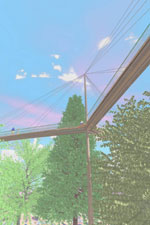
The proposed canopy walkway.
But not every student (or non-student, for that matter) can climb trees using ascenders and mountain-climbing gear. A walkway, by contrast, would allow anyone to experience the wonders of the forest canopy. The idea is to make the connection between humans and trees apparent by building a circular walkway that links the forest directly to our library. In addition to books, the library building houses our computer center, art galleries, and administrative offices. In other words, the building stores many forms of information used by humans. The forest also contains information, but it is stored as species diversity, ecological relationships, and interactions. By creating the physical link between the two, my hope is that users of the walkway will come to see the forest in a different way, in three dimensions and from the perspective of birds and raindrops and pollen grains. You can see more about the walkway on our website.
Today, I’ve been working with the development director at Evergreen to strategize about which foundations and major donors we should pursue next to fund the canopy walkway. It is a project that falls in between the cracks of “regular” foundation giving areas; most foundations don’t want to fund capital projects. The idea has been very well received, but it will still take work to raise the $1 million to make it happen. One thing I’ve learned in coordinating this project is that a project of this scale must be done with an open mind; I have had to be truly receptive to other peoples’ ideas and input. By including the whole campus in the process, the concept has enlarged and improved tremendously. I’ve also learned that I have to to be patient, to accept slowness, to know that a missed deadline just means we have to wait until the next one. These have been extremely hard lessons for me, with my natural tendency to be the boss, to push forward, to go fast, fast, fast. I guess I am learning from the trees, with their long lifespans and their solid, silent way of being.
I found a wonderful passage on this topic in an essay by Herman Hesse:
So the tree rustles in the evening, when we stand uneasy before our own childish thoughts. Trees have longer thoughts, longer-breathing and restful, just as they have longer lives than ours. They are wiser than we are. When we have learned how to listen to trees, then the brevity and the quickness and the childlike hastiness of our thoughts achieve an incomparable joy. Whoever has learned how to listen to trees no longer wants to be a tree. He wants to be nothing except what he is. That is home. That is happiness.
Later in the day, I got a call from Arun Chandra, a music professor at Evergreen. He and I are working on an amazing project that will turn my data on global climate change into music. The idea came to me a long time ago, at a scientific meeting when I was feeling bored by yet another set of standard data slides. Staring at the flat, two-dimensional graph on an overhead projector, I wondered what the data would sound like if we assigned each data point a note or an instrument. What would a tropical forest sound like as compared to a temperate forest? Might we be able to hear patterns that we couldn’t see or derive from statistics?
That question is now being answered through my work with Arun. Ours is a marvelous collaboration! I gave him some data (from a cloud forest nutrient cycling project of mine) in the form of line graphs, explaining that I wanted to hear it. Arun is a brilliant mathematician and musician who immediately understood what I wanted. He worked with the data file for a few weeks, and then invited me to his home office. He then displayed the graph of the data on his computer screen and patiently explained to me how he converted each line of data to a different range of sound frequencies. The result was stunning. I shut my eyes and listened to what Arun had produced. I was thrilled to my socks. He grinned, bright eyes shining with joy, and we both laughed out loud, from our bellies, filled with the delight of a creative project realized.
Wednesday, 1 May 2002
OLYMPIA, Wash.
Today is Canopy Lab Lunch. Every Wednesday at noon, I meet with the small cadre of students who are working or volunteering in my lab on projects related to forest canopy work. Because the Evergreen State College is a small, undergraduate-centered institution, I don’t have many graduate students. So I try to cultivate the spirit of a graduate school lab by having students support each other. Everyone brown bags it and I bring some sort of dessert. We go around the table, and the students recount the progress or problems with their work for that week.
David Franklin reports that he has finished getting the newsletter out, an activity that occurs every four months. The newsletter, which goes out to International Canopy Network members all over the world, includes articles about canopy research, educational and job opportunities, websites and publications of interest, upcoming meetings, and a compilation of scientific citations concerning forest canopies. Each week, I go through Current Contents on Diskette, which compiles large numbers of ecological journals. I look for articles relating to forest canopies and write a reprint request to the authors. We get the reprints, and the list of references — 60 or 70 per issue — goes into the newsletter. Because there is no single journal that publishes canopy work, this is the closest we get to keeping up with the canopy research literature.

A botanically correct camouflage suit.
Another of my “Guggenheim projects” is starting to move forward. I want to make canopy camouflage clothing. When I was out at the ranch in Florida (where my husband grew up), some hunters were standing around in the their camouflage clothing. My first reaction was “yuck — hunters or military people,” but as I looked closer, I was struck by how marvelous it is to wear clothes that depict trees. Unfortunately, the clothes they were wearing didn’t depict any real trees; they were a combination of oak and maple foliage. When I went to Cabela’s catalogue, the clothes for women were very limited in style, stiff, and didn’t fit right. So I’ve been designing my own with the help of a fabric designer. My students are helping out by calling the major outdoor recreation companies — LL Bean, Eddie Bauer, Patagonia, REI — to see if they are interested in my version of camouflage clothing. I think the time is ripe for clothing that depicts botanically correct trees (and helps educate the public). I plan to include a small piece of writing about the trees with every article of clothing, so that when someone stops you at the water fountain, you can speak knowledgeably about your clothes.
Another project I’m excited about involves giving talks about trees and spirituality in churches and other places of worship. I downloaded the Bible and the Koran from the web, searched for the terms “tree” and “forest,” and then categorized each of the references. Interesting patterns came out of that analysis, all of them signaling the importance of trees in the lives of readers of the Bible. So far, I’ve spoken to a Unitarian Universalist church, a Jewish synagogue, and a Zen Buddhist temple, and I’ll be speaking at another church next week. What I really want is a contact that will put me in the pulpit of some sort of fundamentalist church.
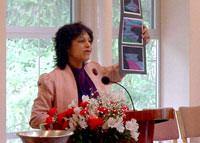
Speaking at a Unitarian church.
Tonight is also our Thoughtcatchers meeting. Thoughtcatchers is a group of like-minded people who enjoy talking about ideas. The idea for the meetings came to me after I had joined a women’s investment club. Neither Jack (my biologist husband) nor I know much about money, so we figured it would be a good idea for me to go to the club. I did enjoy the interactions with the women in the group and appreciated that everyone made a commitment to attend the meetings once a month. The problem was that every time people actually started talking about investments, I got horrendously bored. I would often come away thinking, “Why can’t we talk about something interesting, like new ideas or inventions?” Suddenly, it hit me that there was nothing stopping me from starting my own group.
And so I did, after retrieving my invested money from the women’s group. That was about three years ago, and our group has expanded and continued. We meet in the Urban Onion restaurant; we don’t order dinner (too distracting) but we do get drinks and dessert. Each month, one person chooses a topic and begins the discussion, and then the group takes off. Topics have ranged from sustainability to “What is beauty?” to transformative experiences. Even though it is sometimes hard to make the time for it, I’m always glad when we have the meetings. I would love to see them start up in other towns and cities. Maybe then people would watch less television and talk more about plain old ideas. Or new ones.
Thursday, 2 May 2002
OLYMPIA, Wash.
My Standard Breakfast Boiled Egg was pretty near perfect this morning. Unfortunately, I burned the toast. You win some, you lose some.
Happily, the morning was bright and clear with a kiss of warmth in the air, which bodes well for the peas and beans and strawberry plants sprouting in my garden. I’m afraid I’ve lost the cukes to cold weather this spring. I was impatient, and planted them too early. Typical Pacific Northwest garden story: Just like my breakfast, you win some, you lose some.
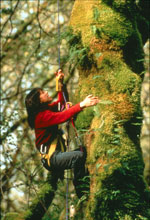
Doing a little tree-climbing.
I was excited to get into school today, because my assistant, David Franklin, was planning to report back about some calls he made for a project I’m working on. This project is being funded by the Conservation Trust program of the National Geographic Society, which supports “new ways of doing conservation.” I proposed to bring a group of artists and economists into the canopy on small, portable platforms in a primary old-growth temperate rainforest (Ellsworth Creek, on the Washington State coast) and in adjacent managed forests. The idea is to have these artists and economists assess the aesthetic and economic value of forest canopy organisms in their undisturbed and disturbed states. This is an effort to tally all of the value in the canopy (not just the ecological value that I study, which is measured using indicators like species diversity, carbon storage, and nitrogen interception and retention) to more effectively assess the importance of conservation.
In addition, I proposed to bring “new eyes” to the canopy — small groups of observers who are culturally or societally inexperienced with trees and forests. These include Inuits from Alaska who were born and raised in the treeless tundra; Paiute Indians from the Arizona desert; urban youth from Seattle and Tacoma; and perhaps most intriguing, prisoners who have been denied access to trees and the outdoors during their incarceration. This summer, we’ll teach these canopy visitors how to ascend into the canopy with mountain-climbing techniques and then ask that they use words or images to convey to us what they see. For example, we had some graffiti artists come up to our canopy platform on campus a few weeks ago, and they created art that encompasses both urban and wildland elements. I think there is a good chance that my ecological colleagues and I will learn new things from canopy newcomers. I was amazed that NGS actually funded the project, but the appeal of a new approach was a strong one. Sometimes far out on a limb is a good place to be.

Canopy graffiti.
I recently got a call of a different kind from the National Geographic Society. It seems the society has entered into a partnership with Toyota to give 12 Land Cruisers to NGS-sponsored researchers and explorers. My Conservation Trust grant makes me eligible for one of these cars. The single requirement is that I appear in a 60-second commercial for the National Geographic channel. The idea of having a great field vehicle — worth $60,000 — for my work in the montane forest of Costa Rica is compelling, especially given the terrible roads and the long distances we travel to our three study sites. But I worry that it would be a sellout to corporate America — ecological researchers helping to sell big gas-guzzling SUVs to upscale people who don’t need such vehicles and might otherwise think twice about buying a car that gets seven miles per gallon. By directly associating National Geographic researchers with a big car — what’s the message? That it is okay, even wholesome, to buy one of these. I’m not sure I want to contribute to this.
The NGS person in charge was sympathetic, and gave me the names of other researchers who have accepted cars. I wrote to and received an email from each of them — one in South Africa, one in the Gobi Desert, and one in England. They love their cars. They had considered the ecological implications, but felt that their research progress outweighed the messages that were being communicated. I looked at the videos of the commercials they made, and indeed they link the glamour of the researcher with the car. Can I do this?
Checking out Toyota’s website, I see that they sell a hybrid car, the Prius, which is a quarter of the cost of a Land Cruiser and gets 10 times the gas mileage. A Prius could indeed work for our project, and would send a far better message: ecologists use ecological cars. I called NGS, and told them that I’d be happy to take a Prius instead. They called back and said it is the Land Cruiser or nothing. I told them thanks but no thanks. The decision feels right, even though I wince to envision my assistants and me negotiating the bumpy roads of our Costa Rica field site on our old motorcycles, big bags of litterfall samples billowing behind us.
The thing is, funding for ecological research is getting harder to get. My last two proposals to the National Science Foundation — the major funder of basic scientific research in the U.S. — got good reviews, but the scores weren’t quite high enough to warrant funding. I’ve received support from the NSF continually since 1987, so I guess I can’t complain, but “It’s a dent in your life,” as my nine-year-old daughter Erika would say. That makes alternatives such as the National Geographic Society look even more attractive.
It is not easy to make decisions that will negatively affect your research, your field assistants, and your contributions to the scientific record. This afternoon, I’ll take my daily run and spend that good alone time thinking over whether or not the Toyota decision of mine was the right choice. And I’ll think about what to cook for dinner for Jack and our kids. And whether I should give up on the cukes and put in some more strawberries instead.
Friday, 3 May 2002
OLYMPIA, Wash.
I’m about to get on a plane to head to Boston, where I’ll attend a meeting at the University of Massachusetts on global climate change and biodiversity. I’ve been invited to give a talk on research, recently published in the journal Oecologia, concerning experimental work we’ve done in Costa Rica on the effects of climate change on the cloudforest canopy communities in montane tropical forests.
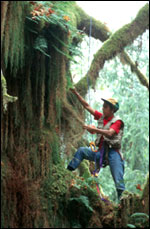
It’s a tough job, but …
The UMass meeting will include both policy-makers and scientists, which should be an interesting combination. It is rare (although, happily, growing more common) that those who do research on ecological and environmental issues speak directly to political decision-makers. We’ll see if we can find a common language during the meeting — and, more important, after the meeting, when we return to our respective institutions and activities.
Thinking about this brings to mind another meeting I recently attended, this one in the mountain community of Monteverde, Costa Rica, where I’ve worked for over 20 years on canopy ecology. The community has attracted both artists and biologists, mainly because of the natural beauty of the montane forests and because of the peaceful lifestyle — historically agrarian, but now more reliant on ecotourism. It is a wonderful place, founded in the early 1950s by a group of North American Quakers who sought a war-free country and found Costa Rica to be a place they could settle and raise their families with no fear of the draft. (Costa Rica abolished its army in the 1940s.)
On one of my recent visits, I had a conversation with Sybil Gilmar, who has begun to organize the independent artists who live in Monteverde. These artists work on projects ranging from pen-and-ink drawings of strangler fig trees to acrylic landscape paintings to jewelry made of seeds to beautiful bowls made of local wood. Over the years, Sybil and I have had many discussions about the similarities between art and ecology. Together, we had the idea of creating a small symposium in which we would bring together an equal number of artists and ecologists, and then pair them off to teach each other how they see, what they learn, and why they create what they create (or study what they study). The symposium was two years in the planning, and we ran it on a shoestring budget. We had no idea what would ensue, but we were sure that it would be something interesting.
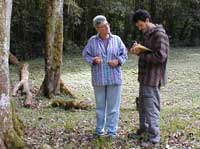
An artist and ecologist compare notes in Monteverde.
Just last week, I returned from the symposium, and felt that it was a wonderful experiment in cross-disciplinary and cross-cultural learning and teaching. We all went out to spend a day in “the Bullpen,” a marvelous pasture where John Campbell, the long-time Quaker farmer who owns it, left intact large trees of multiple species to provide shade for his cows and delight to his spirit. Each artist taught a skill or pointed out a perspective to an ecologist, and each ecologist taught an artist a technique for taking data or making measurements. These exercises helped to de-mystify the two disciplines. The meeting left me with a lot of food for thought — how I might apply the experience to other situations, either in teaching or research.
It has only been in the last few years of my career that I have ventured from the narrow halls of traditional academic studies in forest ecology to explore the intersections of different disciplines. I have gained the courage to do so by being at an institution such as Evergreen, which actively encourages interdisciplinary teaching and learning. I’ve also been blessed with a Guggenheim Fellowship this year, which has given me the flexibility and time to explore these non-traditional realms. Although traditional academia tends to reinforce — and even narrow — one’s perspective, I have learned that there is great value in opening my mind and the minds of my students and colleagues via the kinds of collaborative thinking that led to the Monteverde Art/Science symposium, or to the upcoming scientist/policy-maker meeting in Boston.
There are risks in this approach, risks that may be imagined or may be real. I’m not sure yet. What I do know is that I get great intellectual pleasure from the overlap of fields that are usually considered distant from one another. I also know that the power of artists, economists, and those involved in spiritual thinking — in addition to the knowledge about living systems that ecologists possess — must all be brought to bear on matters of conservation. There is too much at stake to bring anything less to the table; we need and love these trees, and must strive to protect them in any way we can.

